
Let's start with our first Java program!
- Subject:
- Computer Science
- Material Type:
- Full Course
- Author:
- Saeid Samadidana
- Date Added:
- 08/29/2022

Let's start with our first Java program!

Our second set of videos explains how variable are defined and used in Java

Learn more about Java by learning how String variable work. We learn basic text processing tools in this set of videos.

Learn how to develop the famous and simple Hangman game in Java

Let's continue our journey by learning how to develop the Tic Tac Toe game in Java.In this set of videos, we learn about 1D and 2D arrays, debugging the project and loop and if-else structures.
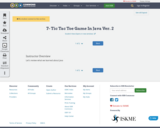
Let's review what we learned about Java
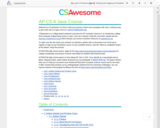
CSAwesome is a free College Board endorsed curriculum for AP Computer Science A, an introductory college-level computer programming course in Java

This activity utilizes a Claim-Support-Question framework that allows students to draw on prior knowledge, investigation, and questioning. Designed to be placed within a Java context of enhancing object-oriented programming classes using interfaceses, students will analyze, implement, and support claims regarding three separate interfaces while moving between analysis and program implementation.

Blueprints is a concise yet comprehensive coverage of Object-Oriented Analysis and Design concepts, suitable for a second programming course in Computer Science. It introduces and teaches application development in a command-line environment, and assumes basic expertise with the Java programming language.

6.035 is a course within the department’s “Computer Systems and Architecture” concentration. This course analyzes issues associated with the implementation of high-level programming languages. Topics covered include: fundamental concepts, functions, and structures of compilers, basic program optimization techniques, the interaction of theory and practice, and using tools in building software. The course features a multi-person project on design and implementation of a compiler that is written in Java® and generates MIPS executable machine code. This course is worth 8 Engineering Design Points.
This course was also taught as part of the Singapore-MIT Alliance (SMA) programme as course number SMA 5502 (Computer Language Engineering).
This textbook covers the traditional introductory Computer Science I topics but takes a unique approach. Topics are covered in a language-agnostic manner in the first part with supplemental parts that cover the same concepts in a specific language. The current version covers C, Java, and PHP. This textbook as been used in several Computer Science I sections over multiple years at the University of Nebraska-Lincoln.

This course introduces abstraction as an important mechanism for problem decomposition and solution formulation in the biomedical domain, and examines computer representation, storage, retrieval, and manipulation of biomedical data. As part of the course, we will briefly examine the effect of programming paradigm choice on problem-solving approaches, and introduce data structures and algorithms. We will also examine knowledge representation schemes for capturing biomedical domain complexity and principles of data modeling for efficient storage and retrieval. The final project involves building a medical information system that encompasses the different concepts taught in the course.
Computer science basics covered in the first part of the course are integral to understanding topics covered in the latter part, and for completing the assigned homework.

This class introduces studies in the algorithmic manipulation of type as word, symbol, and form. Problems covered will include semantic filtering, inherently unstable letterforms, and spoken letters. The history and traditions of typography, and their entry into the digital age, will be studied. Weekly assignments using Java® will explore new ways of looking at and manipulating type.
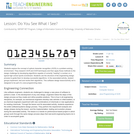
Students explore the concept of optical character recognition (OCR) in a problem-solving environment. They research OCR and OCR techniques and then apply those methods to the design challenge by developing algorithms capable of correctly "reading" a number on a typical high school sports scoreboard. Students use the structure of the engineering design process to guide them to develop successful algorithms. In the associated activity, student groups implement, test and revise their algorithms. This software design lesson/activity set is designed to be part of a Java programming class.
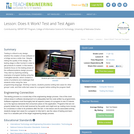
Testing is critical to any design, whether the creation of new software or a bridge across a wide river. Despite risking the quality of the design, the testing stage is often hurried in order to get products to market. In this lesson, students focus on the testing phase of the software/systems design process. They start by exploring existing examples of program testing using the CodingBat website, which contains a series of problems and challenges that students solve using the Java programming language. Working in teams, students practice writing test cases for other groups' code, and then write test cases for a program before writing the program itself.

This course provides an introduction to the fundamental principles and techniques of software development that have greatest impact on practice. Topics include capturing the essence of a problem by recognizing and inventing suitable abstractions; key paradigms, including state machines, functional programming, and object-oriented programming; use of design patterns to bridge gap between models and code; the role of interfaces and specification in achieving modularity and decoupling; reasoning about code using invariants; testing, test-case generation and coverage; and essentials of programming with objects, functions, and abstract types. The course includes exercises in modeling, design, implementation and reasoning.

Epplets present extended Parsons puzzles. In a Parsons puzzle, the student is presented a problem statement, and a program to implement it, but with the lines in the program scrambled. The student must reassemble the lines in their correct order and eliminate distracters. The tutor provides feedback until the student arrives at the correct solution. Epplets help students construct the algorithm for a problem.

This is a foundation subject in modern software development techniques for engineering and information technology. The design and development of component-based software (using C# and .NET) is covered; data structures and algorithms for modeling, analysis, and visualization; basic problem-solving techniques; web services; and the management and maintenance of software. Includes a treatment of topics such as sorting and searching algorithms; and numerical simulation techniques. Foundation for in-depth exploration of image processing, computational geometry, finite element methods, network methods and e-business applications. This course is a core requirement for the Information Technology M. Eng. program.
This class was also offered in Course 13 (Department of Ocean Engineering) as 13.470J. In 2005, ocean engineering subjects became part of Course 2 (Department of Mechanical Engineering), and the 13.470J designation was dropped in lieu of 2.159J.

This Java source file contains the "Guess the secret number" game.Students will learn various Java technologies and programming skills by writing this game.

The Hangman game in Java. Students will learn how to read inputs from the keyboard, how to print outputs, and how to repeat a task using loops.